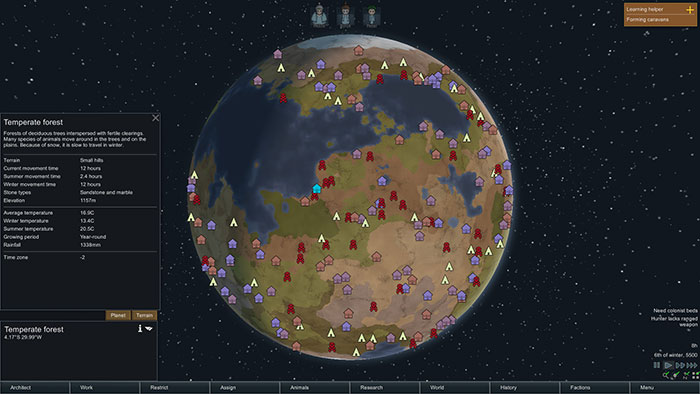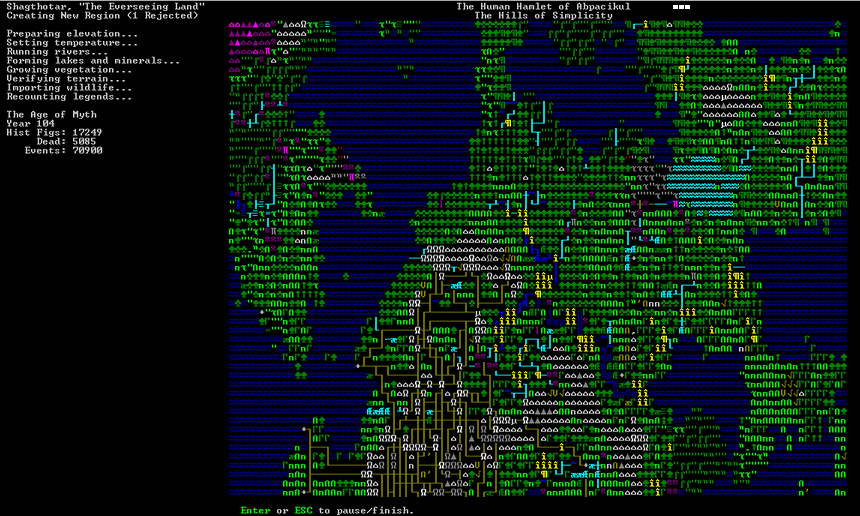Hello folks! This week, after finishing the newest feature, we decided to talk about the future of ProDnD and some new ideas. We took some interest in worldbuilding, using procedural generation and a little bit of noise magic 🙂 While we discussed, we talked about and have drawn inspiration from RimWorld and Dwarf Fortress. In both of these games, you have an enormous procedurally generated world, where you can find mountains, rivers, lakes, deserts, arctics, trees etc… A living and breathing world, calculated with complex noise functions. Every part of the map has quirks of their own, for example, in RimWorld, Arctic parts of a map are inhabitable due to frigid temperatures meanwhile the Jungle part features lots of animals and trees etc…
Here you can see the RimWorld’s and Dwarf Fortress’ maps:
RimWorld:

Dwarf Fortress

Since our app ProDnD emulates this kind of setting with smaller parts (procedurally generating caverns, taverns, dungeons etc…) we asked ourselves why don’t we take things further and advance our worldbuilding methods? We revolved around these ideas and came up with a couple of ideas.
First of all, we thought of possible use cases. Take one DM, who wants to create a map for their game. A dungeon, goblins lurking in the shadows, and scary skeletons… A dreadful atmosphere…
At this moment, we thought of prompting some questions to the user. Instead of giving out maps as templates, we thought of going onto the user’s requests. What kind of map do you want? A dreadful dungeon, filled with treacherous creatures? A sunny and lively city square? A tavern, filled with beer lovers and eavesdropping sneaky rogues? Maybe a temple on a desert? Maybe a forgotten dwarven city, under the depths of the mountains? At this point, we aimed to be more “human readable” in order to enhance user experience. The user will fill out some prompts and then the app will generate according to the needs of the DM. For example, in the parameters of the maps, instead of using “Noise” to indicate the amount of the noise applied to the map, we will change the name to “Elevation”, “Water Level” or “Tree Density” to indicate the name of the element that’s applied, and they will have selections to choose from as well. E.g. Water Level: Dry, Puddle, Lake, Sea, Ocean. Elevation: Flat, Hills, Mountains, Impassable, and such…
Also, in addition to this kind of prompts, we thought of a literal world like in these games mentioned above. Areas such as Arctic, Savannah, Desert, Temperate Forest, Jungle, Island in the middle of the ocean…
And when this world is generated, the user will select an area on this world and will be able to see its features. Hot, cold, barren, flooded, jungle, dry… We are aiming for letting the users select a variety of options and come up with unique results. Instead of giving out crude templates with smaller chunks, why not offer the whole world as a playground instead of disjointed maps? We could even add seamless worlds that interconnect with each other.
A party, encountering a rocky mountain, decides to enter a smaller gap that leads to a cavern that is home to goblins. After they get out of this cavern only now adorned with battle scars, they see a forest, hiding ahead. The forest seems fine on the outside, but inside there are lots of swamps and annoying insectoid creatures along with a lake in the middle… A temple lies within the swamp-forest which needs going to, but the land is not forgiving nor the destination, there’s a dungeon that just looks like a maze, easy to lose your way and mayhaps lose what’s left of your mind too…
I just threw some ideas but you get the idea 🙂
So these are the results of our brainstorm. I hope that we can come up with crazy ideas to entertain our lovely DMs and blast fun and interesting tabletop RPG sessions 🙂
Stay in tune!
